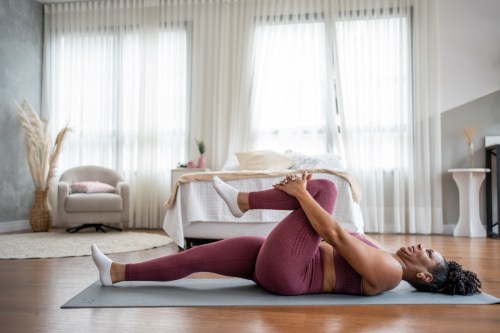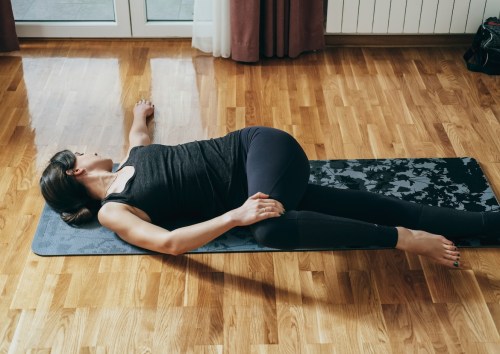No matter if you’re an exercise newbie or a veteran athlete, you’ve likely heard of active recovery—whether or not you know exactly what it is. Rest days are important in any routine, but it turns out the best active recovery workout may be just as good (or better) at promoting optimal healing of worn-out muscles, so you come back stronger more quickly.
Experts in This Article
certified personal trainer, five-time marathon runner, and Ladder strength training senior coach
personal trainer and and stretch practitioner for StretchLab
Even as a long-time recreational athlete, I’m new to incorporating active recovery. I’ve always had self-planned run days, strength training days, and full rest days. However, this year, I decided to work with a trainer to prevent injury in my middle age.
We agreed upon two days a week of strength training to complement my running. When I checked my training app, I was surprised to find three workouts.
One of them was labeled “active recovery.” That was not what we discussed—did I have to give up one of my precious rest days? But I enlisted his help for my own good, so I had to give it a try.
Let’s just say, I’m now a believer. That recovery workout was the perfect amount of activity to help me loosen my stiff and achy joints and muscles, without breaking a sweat.
So how do you know how much to do on your active recovery days? Are active recovery days better than rest days? And how often should you do them?
We looked to personal trainers to answer these questions and share their must-do moves to create the best active recovery workout.
Benefits of active recovery vs. total rest
What’s the benefit of doing active recovery over a low-key, lazy day? “When we move, we are promoting blood flow,” says Nicole Winter, CPT, senior coach at Ladder. “I’m sure you’ve heard the term ‘motion is lotion’, which is exactly why incorporating active recovery can be so important to help our bodies recoup after a tougher bout of exercise.”
Anyone who’s spent hours on the couch knows it stiffens your joints. Admittedly, as a writer and Grey’s Anatomy binge-watcher, I often spend my breaks hobbling to the bathroom or the fridge. But the benefits of active recovery show that it’s worth doing.
1. Improved recovery time
Exercise fatigues your muscles and your body adjusts to the demand by rebuilding muscle tissue. Active recovery can improve1 this recovery period.
While rest is an important part of the fitness equation, Sean Steerforth, NASM-CPT, stretch practitioner for StretchLab, recommends active recovery over low-activity rest days because of the benefits.
“[Active recovery] enhances blood circulation, reduces muscle stiffness, and aids in quicker muscle repair, while still allowing the body to rejuvenate without the intensity of regular workouts,” he says.
2. Reduced pain and inflammation
Delayed-onset muscle soreness (DOMS) is no joke. It’s uncomfortable to sneeze, laugh, or sit. Leg day got you dreading a simple bathroom break? Muscle edema (swelling) and inflammation may be contributing to your sore and stiff muscles—and active recovery can help.2
When you push yourself through a tough workout, your lactate levels increase. The buildup of lactate, or acidosis, can cause tenderness in your muscles. The quicker your body removes the lactate, the better you’ll feel. When compared3 to passive rest, active recovery significantly speeds up the process.
Some research4 suggests active recovery may provide the anti-inflammatory benefits of a cold plunge, without freezing your tail off.
3. Improved flexibility and mobility
Dynamic stretching—deliberate stretching that moves through the entire range of motion—should be a regular part of the best active recovery workouts. Stretching can improve5 the range of motion around your joints. This allows you to become more flexible.
While you don’t need to be as flexible as a world-class gymnast, improved flexibility will pave the way for more efficient movements and reduced risk of strain. Adding in mobility work helps your muscles become more pliable so you’re able to improve your mechanics—and avoid injury.
What is active recovery?
Most exercise causes some sort of physical stress to our bodies. That stress can be a good thing, if we allow our bodies to recover and adapt to the training load; we come back fitter and stronger. Recovery and repair are just as important as your tough workouts.
“Active recovery should look like a super relaxed, low-impact workout.”—Nicole Winter, CPT
Exactly what qualifies a workout as active recovery vs. a regular workout? The effort. According to Winter, you shouldn’t be pushing yourself. “Active recovery should look like a super relaxed, low-impact workout. Your heart rate should remain at a lower steady state without spiking.”
During your regular workouts, you’re challenging yourself—moving out of your comfort zone. Active recovery is the opposite. “Keep your heart rate at 30 to 60% of your maximum, to ensure the activity promotes recovery without adding significant stress to your body,” suggests Steerforth.
To estimate your maximum heart rate, take 220 minus your age. Then multiply by 0.3 and 0.6 to get your target range. (If you’re 35, your MHR is around 185 beats per minute. So the best active recovery workout will keep your heart rate under 111 bpm.) It shouldn’t take much movement to get to that target.
How often should you do active recovery?
If you’re looking to gain strength and overall fitness, how often do you need an active recovery day? Winter incorporates one day of active recovery every week for her clients. “That means I program a guided stretch that lasts about 10 minutes. It’s a great way to build in structured active recovery if that is what you prefer.”
One day a week, low effort, and only 10 minutes? Sounds pretty doable.
What sort of exercise is best for active recovery?
The type of exercise you choose to do on active recovery days is completely up to you, but remember to keep it low-key.
“For active recovery, you’ll want to implement LISS, which stands for low-intensity steady state cardio, or mobility and dynamic stretching. This could be a stroll with your dog, a 15-minute yoga flow, or an easy-paced cycling session,” says Winter.
Don’t want to pick your own? The exercises below, from both Steerforth and Winter, combine into the best active recovery workout.
How to do the best active recovery workout
1. Walking
It doesn’t get simpler than this. Whether on the treadmill or outside, “walking is a very simple and easy way to get the blood flowing and a bonus that you’ll get some extra steps in,” says Winter.
- 1.Keep your head up. Rather than looking down, try to maintain level sight.
- 2.Relax your shoulders and allow your arms to swing naturally while somewhat bent.
- 3.Your pace should be moderate, fast enough to slightly increase your heart rate but slow enough that you can comfortably carry a conversation.
- 4.This part of your active recovery workout can vary based on the time you have or your daily step goal, but aim for at least 7 minutes.
2. Standing quad stretch
Is your bottom half sore from leg day? “This stretch targets your quads. I like this movement because it also helps with balance and releases tension in the quadriceps,” explains Steerforth.
- 1.Start with your legs shoulder-width apart.
- 2.Tuck your pelvis in and tighten your right glute muscle.
- 3.Grab your right foot and pull it up, getting it as close to your glute as possible.
- 4.Keep your shoulders down and back.
- 5.Focus on a point on the floor to help with balance, or hold on to something to keep you stable.
- 6.Hold for 30 seconds, then switch sides.
3. Downward dog to upward dog
Simple, yet effective! “Working through yoga flows like a downward dog to upward dog, or a forward fold to halfway lift, will allow you to feel in tune with your body and work through any soreness you may have from your workout the day prior,” says Winter.
- 1.Start on all fours. Keep your hands shoulder-width apart with your fingers spread. Your legs should be hip-width apart.
- 2.While tucking your toes and engaging your core, lift your hips up and back. Try to keep your legs straight to form a “V” with your body.
- 3.Hold for a breath and shift down into a plank, keeping your elbows near your body.
- 4.Lower your hips toward the floor and lift your chest up and forward.
- 5.Keep your shoulders down and back while you look forward, keeping your neck in a neutral position. This is upward dog.
- 6.Hold for a breath and transition back to downward dog.
- 7.Repeat this flow for 1 minute, bringing your knees to the floor if you need a break.
4. Forward fold
Steerforth recommends this stretch because it is good for your low and mid back, and hamstrings. “This is a good movement because a lot of exercises can put stress on your back and hamstrings.” For an added twist, try lifting one arm to the sky when your back is at 90 degrees.
- 1.Stand with your legs slightly wider than shoulder-width apart.
- 2.Bend over at your hips, keeping your back straight and knees slightly bent as you try to touch the floor.
- 3.As you breathe out, sink your upper body toward the floor, fully releasing.
- 4.After a breath, place your hands below your knees and lift up slightly to bring your body to a 90-degree bent-over position.
- 5.Hold for a breath and sink back down.
- 6.Repeat for 30 seconds.
5. Targeted stretching
Find your tight spots and target them with some slow stretches. Winter says working through both dynamic and static stretches “will increase blood flow to the muscles along with benefiting your range of motion.” This stretch from Winter is great for targeting sore quads and hamstrings.
- 1.For the hurdle stretch, start by sitting on the floor.
- 2.Bend your right knee and place your right foot slightly behind you.
- 3.Extend your left leg straight in front of you, with your toes pointing up.
- 4.Keeping your chest up, grab your left foot with your left hand until you feel a stretch in your forward leg.
- 5.Hold the stretch for 3 breaths and switch sides.
- 6.Repeat for 30 seconds.
6. Low lunge hip opener
Stiff from sitting? “This move opens up your hips and stretches your hip flexors and your hamstrings,” says Steerforth. You’ll also get a nice mid-back stretch.
- 1.Begin by kneeling on your right knee, with your left leg bent at a 90-degree angle in front of you.
- 2.Keeping your chest and head up, slowly lean forward. You should feel a stretch in your right hip flexor (front of hip).
- 3.Place your right hand on the floor parallel to your left foot and raise your left arm above your head, in line with your right arm.
- 4.Hold for a breath.
- 5.Switch sides and repeat for 30 seconds.
Bartolomei S, Totti V, Griggio F, et al. Upper-Body Resistance Exercise Reduces Time to Recover After a High-Volume Bench Press Protocol in Resistance-Trained Men. J Strength Cond Res. 2021;35(Suppl 1):S180-S187. doi:10.1519/JSC.0000000000002960
↩︎Ma F, Li Y, Yang J, Li X, Zeng N, Martin RL. The effectiveness of low intensity exercise and blood flow restriction without exercise on exercise induced muscle damage: A systematic review. Phys Ther Sport. 2020;46:77-88. doi:10.1016/j.ptsp.2020.08.011
↩︎Mota MR, Dantas RAE, Oliveira-Silva I, et al. Effect of self-paced active recovery and passive recovery on blood lactate removal following a 200 m freestyle swimming trial. Open Access J Sports Med. 2017;8:155-160. Published 2017 Jun 28. doi:10.2147/OAJSM.S127948
↩︎Peake JM, Roberts LA, Figueiredo VC, et al. The effects of cold water immersion and active recovery on inflammation and cell stress responses in human skeletal muscle after resistance exercise. J Physiol. 2017;595(3):695-711. doi:10.1113/JP272881
↩︎Opplert J, Babault N. Acute Effects of Dynamic Stretching on Muscle Flexibility and Performance: An Analysis of the Current Literature. Sports Med. 2018;48(2):299-325. doi:10.1007/s40279-017-0797-9
↩︎
Sign Up for Our Daily Newsletter
Get all the latest in wellness, trends, food, fitness, beauty, and more delivered right to your inbox.
Got it, you've been added to our email list.











